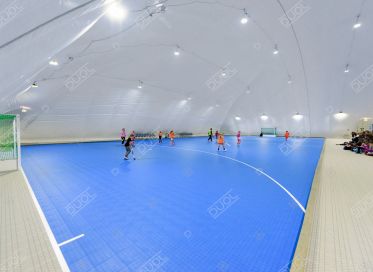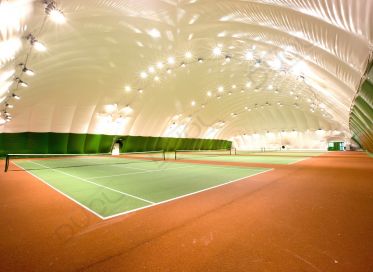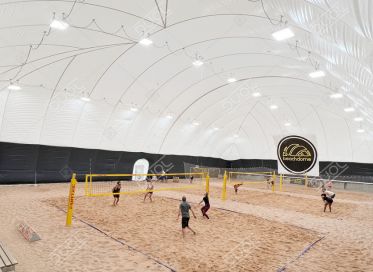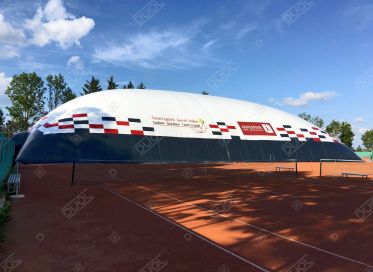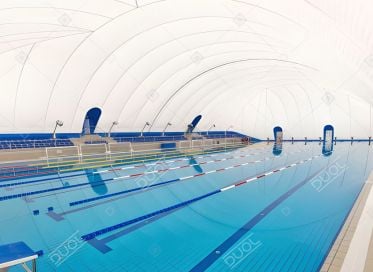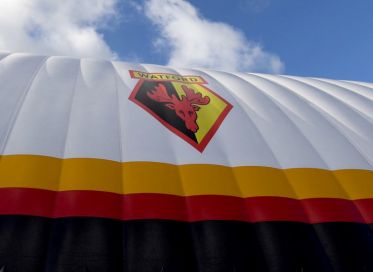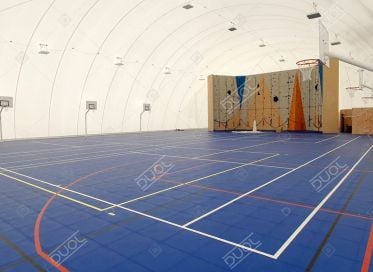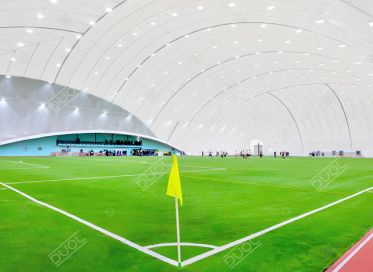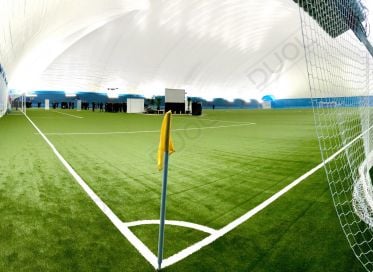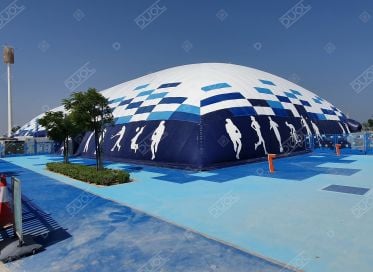GENERAL QUESTIONS
How does an air dome work?
The ventilation system provides a slight overpressure inside the air dome, ensuring a proper form for the dome, as well as stability of the pneumatic building in every climate condition. The same ventilation system can have a heating and/or cooling option which provides the desired temperature inside the dome. The system is controlled automatically (automatic pressure & heating regulation with an emergency backup system). The membrane’s role is identical to walls and roof in conventional structures.
What are possible air dome applications?
An air dome is suitable for any application which requires a clear span. It can be used for sports such as football, tennis, volleyball, handball, badminton, basketball, swimming etc. Other applications are also possible, like warehouses, industrial facilities, events, military, agriculture etc.
What is the optimal pressure inside the air inflated structure?
The standard pressure inside the air inflated structure is 150- 250 Pa under normal conditions, depending on the dome size and specifications.
Does the ventilation system need to work continuously?
Yes. It is necessary to provide a certain amount of air in the structure continually. Simultaneously, this provides fresh airflow to the airdome to keep a healthy, fresh and cool environment for the visitors inside the dome.
No time for reading FAQ? Contact us and we will answer any questions you may have about your new project.
With free project consultation & quote! Feel free to contact us today.
TIMING
What is the lead time for an airdome manufacturing?
Lead time depends on the project. Standard lead time is 2-3 months from the approved drawings until the airdome being ready for delivery.
How long does it take to build an air dome on-site?
The airdome components are modular and prefabricated which makes the installation process easy, quick, and cost-effective. The actual schedule depends on the air dome size and specifications. Standard air dome assembly time is 4-7 days (for domes covering up to 5 tennis courts) and 7-21 days for larger ones (full-size football field, industrial domes, etc.)
Are there any limits to airdome inflation in a specific moment?
Sometimes extreme weather conditions (such as storms, floods, or heavy snow) can cause difficulties with erecting the airdome. In such case it is suggested to wait for better weather conditions, if possible.
STRUCTURE & DESIGN FLEXIBILITY
Is it possible to design the structure exactly upon customer's requests?
Yes, each structure is unique. Dimensions, different colours, patterns, logos, etc. are designed upon customer's requests.
Is it possible to attach the structure to the existing building?
Absolutely! The air dome can be fixed to other buildings in different ways. Air dome has a flexible design which enables it to be installed even on top of existing buildings.
Can the air dome structure be used temporarily or seasonally?
Definitely, the air dome structure could be dismantled in a period when it is not used. It requires only a few days to assemble and disassemble the air dome structure easily and with minimal effort.
Is it possible to move the air dome to another location?
Yes. The air dome could be easily disassembled and relocated to the new site.
How is the membrane of the air dome stored
The fabric should be protected and stored in a dry place.
What are the maximum dimensions of the structure?
There is no maximum size, we design, manufacture and install any reasonable span. However, if the span is enormous, the air dome cost will gradually increase.
Is it possible to have panoramic windows into the air dome’s wall?
Yes, it is possible upon request.
What colour of the fabric is used in a air dome production?
The standard colour is white. The client can choose a variety of different colours. However, air dome prices and production time might vary.
SAFETY PLANNING
Is the air dome tent equipped with any certificates?
All parts of the air dome tent are certified. Air dome elements are manufactured in the EU and designed according to EN 13782 standards. All the elements are CE certified to meet the following criteria:
- Safety (energy autonomy, weather resistance, seismic safety, approved and valid calculations, safety design and planning, simple control);
- Technical (systemic solutions, high technology in design and materials, easy installation, fast assembling, quick dismantling, easy relocation);
- Aesthetic: 3-D CAD/CAM program design, 3-D visualizations, computer-integrated manufacturing.
What happens with the structure in the case of a power failure?
Reliability and safety are the most essential air dome features. A constant power supply is a critical item which must not be left to chance. Every air dome is equipped with an emergency backup system, which intervenes immediately in case of local electricity supply failure. It has 12-48 h autonomy, which can be extended up to 100h if required.
What is the back-up unit/system, and how does it work?
The back-up unit is an auxiliary emergency system, equipped by a diesel engine. Every air-supported structure is equipped with an emergency/backup system that ensures the stability of the structure in case of an emergency situation, such as pressure loss or exceptional weather conditions (extreme wind, snow). It works independently from electrical supply. It is sensitive to inside pressure fail, electricity break.
Is the fabric flammable?
No, the fabric of the dome is flame-retardant (due to its particular chemical substances) and approved by international certificates.
Is the fabric dome resistant to vandalism?
Because of the fabric's strong polyester net sub-base, it is difficult to damage. Furthermore, thanks to the double membrane system, fabric domes are very rigid and vandalism-proof. In case of any damage on the outer membrane, the inner membrane still holds the proper airtightness and hence maintains the air dome stability.
Does the air-supported structure collapse if the fabric is cut and a hole emerges?
No. The air-supported structure is an autonomous structure, which means that in an emergency it will maintain itself. The air-supported structure stability is provided by the emergency inflating unit, switched on at the detected minimal pressure drop.
How can damaged fabric be repaired?
The fabric can be easily fixed with the manual welding kit.
How much time is needed to evacuate people from the air dome in the case of an emergency?
The air domes are equipped with many emergency exits, which can be used to evacuate the airdome effectively. Furthermore unlike a traditional building, an air dome does not suddenly collapse, it takes time to be deflated, which gives persons inside an air dome enough time to evacuate.
How many emergency exists are needed?
The quantity of emergency exits is determined considering air domes size, the purpose of use and the fire and safety measures in each specific country.
WEATHER RESISTANCE
Is the fabric dome resistant to extreme cold or hot weather?
Yes, all parts of the fabric dome are temperature resistant in the range from -55 to +70°C, depending on the project requirements.
Is the fabric roof resistant to a heavy snow load?
The structure resists an enormous amount of snow up to 480 kg/m2. The combination of the air dome shape, internal heating and the perfect flat surface ensure that the snow slides easily from air dome.
Is the air dome structure wind resistant?
The structure is resistant to wind speed up to 250 km/h.
Is the fabric roof resistant to heavy rain or hail?
Yes. The fabric roof is resistant to hails hits.
Is it possible to erect the airdome at high altitude, for example at 3000mt?
Yes, it can be easily adapted to such climate conditions.
Is it possible to erect the airdome near the sea?
Yes, in such case the dome should be protected against corrosion.
Is it possible to erect the air dome in a seismic area?
Yes, the airdome is 100% resistant to earthquakes.
TECHNICAL QUESTIONS
- Membrane system -
What is the material of the air dome wall, and how is produced?
The membrane system consists of two or more layers of the membrane, which are welded together using HF (high frequency) welding technology. The outer membrane is stronger, made by high tenacity polyester fabric, and protected with special lacquering, to hold all the forces and outer influences. The inner membrane is lighter and acts as an insulation layer. At appr. every 3m meter strip, the membrane is welded by HF welds where the four membranes are overlapped and welded together to ensure the strong reinforcement in the vertical and horizontal direction. Standard membranes are UV-resistant and with the use of unique lacquering finish like Polyvinylidene fluoride (PVDF) or Titanium dioxide (TiO2 ) this resistance is even better, which increases membrane quality and lifetime. The standard fabric completely meets physical, technical, and fire standards as well as regulations.
Is the fabric translucent?
Yes. Translucent fabric is used in a production of standard air domes for maximum daylight utilisation.
- Anchoring system -
How is the air dome anchored to the ground?
Every air dome needs a simple foundation only around the perimeter of the site to keep it anchored and secure. Different systems are possible to attach the air dome to the ground:
- Rings with peg crossed by metal pipes inbuilt into concrete beam
- Metal profiles inbuilt into concrete beam
- Ground-anchoring system (anchoring without concrete foundation)
Does the air dome need lightning protection?
No
- HVAC -
What types of units are used to blow air into the air dome?
Inflating units, with air capacity 5.000 - 120.000 m3/h and power 1– 30kW, are used to provide air inflating into the air dome. On-demand there are also more advanced options possible:
- DFS – Double Fan System; modular fan operation, increased reliability
- Improved modulating system (saving up to 50%)
- High-efficiency heat exchanger
- High efficiency condensing units (up to 105% efficiency)
- Silent operation - a radial fan of low noise, silencers
What is the heating source?
It is possible to heat the airdome with natural gas, LPG, oil, hot water or steam, electricity, heat pump, biomass, or combined source.
Could the air dome be equipped with A/C?
Yes, DUOL has accomplished many projects in the Middle East, Asia and South America as well in some areas with extreme climatic conditions. DUOL air dome membrane is uniquely designed to withstand temperatures up to 70 degrees Celsius. Our airdome are designed AC-ready together with high thermal membrane insulation which reduces the heat entering the dome and maintains the climate inside the dome. The air conditioning system withstands heat up to 70 degrees Celsius.
What is the noise level from the machinery?
The noise level is minimal to the surrounding environment. The main ventilation unit produces a noise of 50 to 70 dB, and the backup emergency unit 70 to 85 dB. If required, there is also an option for a ventilation unit that is featured with a silent mode. It can be equipped with silencers.
Could the pressure inside the airdome be regulated?
Yes. The pressure is controlled by regulating the recirculation and setting of the inflating unit's power.
- Lighting System -
What kind of lighting system is used in the air dome?
The proper quantity of LED Lights will ensure the correct level of illumination inside the airdome. It can be installed in two different modes: direct or indirect. In the direct lighting system, the light is mounted on the ceiling. With the indirect lighting, the projectors are installed on metal poles that are directed upwards, and the light is reflected from the air dome membrane to light up the entire dome.
Which option is better: direct or indirect?
Both systems have their advantages. Based on the project’s specifications, we will recommend which option is better.
- Entrance doors -
Could the regular one-wing doors be used to enter the air dome?
No. The air dome is an airtight structure. Only revolving doors or airlock doors can be used to maintain the air pressure inside the air dome and avoid any air leakage.
Is it possible for a vehicle, truck, or a forklift to enter the airdome?
Yes, access is possible through the Vehicle & Equipment Airlock Access Door. There are two standard types of DUOL Vehicle & Equipment Airlock Access Door: T60 with standard dimensions of (6m x 3mm x 2.5m) and T80 with standard dimensions of (8m x 4m x 4m). However, the size can be customized upon the client’s request. The Vehicle & Equipment Airlock Access Door is meant to be an entrance for vehicles, a storage room of the equipment, or an auxiliary space of the object.
Are there any entrances suitable for people with special needs?
Yes, accessible doors are available. They are also useful for hand-truck deliveries. Two doors are built in a frame with a short connecting tunnel creating an airlock system, thereby maintaining the fabric dome building pressure and minimizing air loss.
BUILDING SITE QUESTIONS
What kind of infrastructure is needed to build the structure?
It is required to build a simple concrete foundation around the perimeter of the air dome. Providing electricity supply and the heating source at the site (If heating is part of the project) is necessary.
Are there any requirements on permits to erect an air dome?
To build/erect the air dome either a building permit or a manufacturer’s statement for EN 13782 standard is required. For accurate information, we recommend that you refer to the local authorities since procedures are different from one country to another.
What about the electricity and heating supply in the airdome?
It is required to provide the requested quantity of electricity and heating power depending on the specifications of the ventilation unit. In the drawings the location of the connection points will be marked.
Where are the heating-ventilation units located?
Units are optimally located in the middle of the shortest side of the air dome and within the distance not more than 1,5m away from the airdome. On request, it is possible to locate the units further away from the dome, making ventilation pipes for each project separately.
Where are the doors and tunnels located?
The door location is selected upon the client’s request. The only condition is that the distance between the revolving door and the dome's corners should not be less than 3m, or 6m in case of the vehicle access door.
Does the client decide on the location of doors/tunnel/heating-ventilation units?
Yes, but DUOL takes the above-mentioned restrictions into consideration.
Does the air dome manufacturer provide project/technical documentation?
DUOL provides all the technical documentations for the structure. Furthermore, we assist you with any required documents which help the investor to receive a building permit.

Didn’t find what you were looking for?
The DUOL team is always here to provide you with all the information you are looking for and to advise you in finding the solution that best meets your needs.
For any question or any further information, feel free to contact us.






